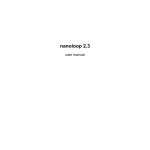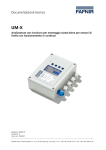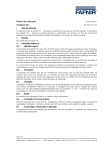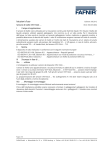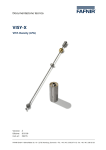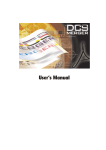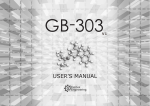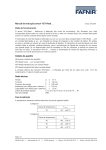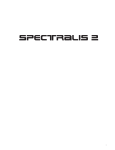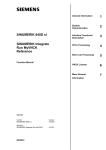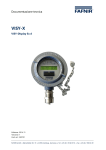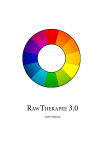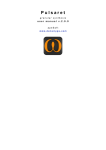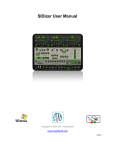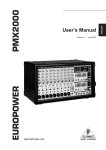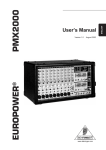Download nanoloop 1.5
Transcript
nanoloop 1.5 user manual Introduction Nanoloop is a Stepsequencer which means that a pattern of 16 1/16 notes is played repeatedly while these notes can be edited in various respects like volume, pitch etc. There are four channels, playing simultaneously. Each channel's patterns can be saved to file slots in flash memory and are then available for new combinations. Finally, saved patterns can be arranged in a song structure. Startup Start nanoloop with START. If you keep A+B+SELECT pressed during startup, the ROM checksum will be calculated. If you keep A+B+START+SELECT pressed during startup, memory will be reformatted and all saved data will get erased. 2 The Sequencer The 16-step pattern is shown as a matrix of 4 x 4 squares with the currently playing step marked in slightly darker color . The current channel is displayed in the upper left corner, the current edit parameter in the upper right corner. Within this matrix, the cursor can be moved around with the d-pad. Use the keys to set notes: B A Set note Remove note / paste removed note if step is empty 3 To edit a note, keep B pressed and press the d-pad up / down (▲/▼) or left / right (◄/►). This changes the value of the current edit parameter, indicated by little dots and squares changing their position. On startup, the edit parameter is pitch and B + ▲/▼ changes pitch semitone-wise while B + ◄/► changes the octave. To select a different channel or parameter, call menu 1 with SELECT Menu 1 In menu 1 you can select channel and edit parameter. Furthermore, all notes in the sequencer can be edited simultaneously. ◄/► ▲/▼ B select parameter select channel return to sequencer A + ◄/►/▲/▼ edit all notes at once SELECT switch to menu 2 (see page 8) 4 Channels There are three tonal channels and one for noise: R L S N rectangular wave double rectangular wave custom wave form shift register noise The rectangular waves have a variable pulse width of 4 steps, with the 4th sounding identical to the 2nd. The custom wave forms are defined in the wave form editor (sine by default). The shift register is a pseudorandom noise generator with variable frequency and two different register modes. R,L and N have a volume/envelope resolution of 15 steps while S has only 3 steps. The additional voice of the L-channel is only audible on greyscale Game Boys (DMG and GBP). It is a square wave, the pulse width setting has no effect. Its envelope is always in decay-mode, pitch envelope/LFO has no effect and it does not play if the note is delayed. Edit Parameters The following parameters are available for editing in the sequencer: 5 Volume / Envelope B + ▲/▼ B + ◄/► START volume length set attack-, decay-mode (R, L, N only) In attack-mode, the envelope is infinite. it starts at the selected volume and increases to the maximum. Pitch B + ▲/▼ START semitone set chord-mode in normal mode: B + ◄/► octave (N: toggle tonal and noise mode) in chord mode B + ◄/► B + A + ◄/► B+L select note octave On channel R, S and also N chords are played as arpeggio. On the Lchannel, the second note controls the second voice, the third note detunes the first voice and the fourth note has no effect. 6 pitch envelope / lfo B + ▲/▼ B + ◄/► START amplitude length / frequency envelope- / lfo-mode START on an empty step activates / deactivates the slide mode: Long previous notes are pitched up or down slowly. B + ◄/►sets slide in 6 semitone steps, B + ▲/▼sets it in semitones. This has no effect on N. wave / delay B + ▲/▼ B + ◄/► START R/L: pulse width, S: wave form delay note in 1/256 steps play original note plus delay or only delay pan B + ◄/► pan position 7 Menu 2 Menu 2 provides links to sub-menus and some functions that affect the entire channel. SELECT returns to Menu 1. B call file menu B call song editor B + ◄/► B + ▲/▼ START A+B shift pattern backwards / forwards invert pattern copy pattern paste pattern B call wave form editor B + ◄/► B + ▲/▼ A+B START global tempo in BPM set channel tempo to fraction of global tempo external sync internal sync 8 File Menu In the file menu, patterns can be saved to file slots in flash memory for persistent storage in 15 banks. In each bank there is a row of 15 slots for each channel (slot 0 is not writeable). SELECT returns to menu 1. File Operation ◄/► ▲/▼ select file slot select channel A +◄/► select bank (bank no. in upper left) B+▼ B+▲ save current pattern to selected slot load pattern from selected slot A+▲ load all patterns from selected column B+► B+◄ load pattern on next beat load pattern with tempo 9 B + START data communication mode The cursor jumps to the upper left corner in data communication mode. Tempo The current tempo is saved with each file but not loaded with B + ▲ to avoid unwanted tempo changes. Use B + ◄ instead. Waves When changing bank, the new bank's wave set is loaded automatically which may cause sudden changes in sound. Flash Memory Data are stored in flash memory on the cart. Unlike normal cartridges, nanoloop has no cart battery and memory can not be wiped out during a crash or instable power supply. 10 data communication A+B+▼ receive bank The current bank is overwritten with data received through the link port. The number of remaining blocks is showing and two checksums are displayed when the transfer is complete. If they are the same, data are intact. A+B+▲ send bank The current bank is sent in form of audio pulses and through the link port. When exchanging data between two nanoloops via link cable, make sure that both are in data communication mode before starting the transfer. CAUTION: The encoded audio is not music but loud pulse noise. It is not meant for listening but for (mis-) using audio media for data storage. Please make sure the audio output is not connected to an amplifier / speakers before playing the encoded data. Please read the detailed instructions available on www.nanoloop.com before using these functions. 11 Song Editor The current bank's saved patterns can be arranged to a song. The song structure is organized in 16 pages, if you move the cursor to the far right or left, the next / last page is displayed. B + ▲/▼ B+► A+▲ A + ◄/► A+B START select pattern copy current value to next step load patterns on cursor position next / previous page select /deselect current channel for tempo start / stop song playback SELECT return to menu 2 When leaving the song editor, playback is stopped and the song is saved. (the song is not saved when the device is turned off without leaving the song editor) 12 Wave Form Editor There are 16 wave forms per bank which can be assigned to notes in the S-channel. ▲/▼ A START SELECT select harmonic mix selected harmonic to current wave toggle wave selection / wave drawing mode return to menu 2 and save wave set wave drawing: B + ▲/▼/◄/► draw wave wave selection: ◄/► B + ▲/▼ select wave copy / paste wave 13 Additional Notes Mapping Due to programming limitations, parameter settings have the same range and resolution for all channels. However, the actual sound generators sometimes have different ranges. In cases where the range is smaller than the possible settings, settings are mapped to the available values. Sync Procedure for syncing two nanoloops: - set the master to slave mode (A+B) - set the slave to slave mode (A+B) - start the master (START) After playback was interrupted, the slave has to be reset with A+B. 14 Further information and a discussion forum can be found at the nanoloop website: www.nanoloop.com For questions and comments please send an email to [email protected] Postal: ume software Bahrenfelder Str. 53 22765 Hamburg Germany (c) 1998-2009 Oliver Wittchow Nintendo has not recommended, authorized, endorsed, approved of or licensed Nanoloop. 15















